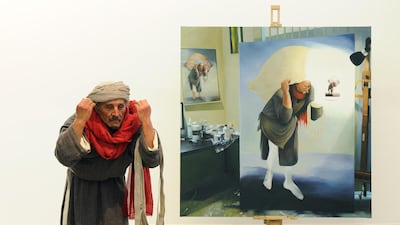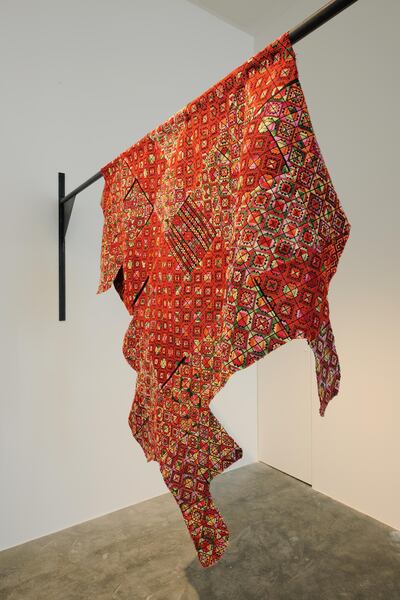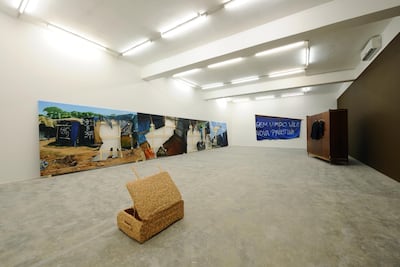Greeting visitors to Beirut’s Sfeir-Semler Gallery for the next six weeks are four maps, each a patchwork from intricate, colourful embroidery. Laid out on the ground are: a map of the Dead Sea, picked out in rich shades of blue and purple; a map of the Gaza Strip in bold red and orange tones; and a map of the West Bank in earthy greens and browns. A fourth map hangs folded over a metal strut protruding from the wall of the gallery.
Entitled Hide Geographies, a play on words evoking both hidden spaces and the skins of hunted animals, they represent "defeated geographies", as Palestinian artist Khalil Rabah poetically puts it. The four maps are among the pieces on show in New Sites for the Museum Departments or four places to visit Heaven, Rabah's latest solo show. Each map corresponds to one of the "departments" in which his work is arranged.
The artworks are all part of an ambitious project on which Rabah has been working for more than 20 years, titled The Palestinian Museum of Natural History and Humankind.
Rooted in the history and geopolitics of Palestine, it seeks to challenge and subvert traditional representations. Rabah’s decision to adopt the language and rigid structures of western museology provides him with a means to question the ways in which history is socially constructed through materials embedded in culture and identity. The curation of the work is central to the message and concept of the exhibition. “What I’m showing now is a new kind of curatorial approach looking at what happens when things are taken from their places and their time and put in a new context,” he says. “What do they reveal about their history? How are they relevant to the current time and to the current conditions?”
In the first gallery, titled Area C Fields of Gold, Botanical Department, which corresponds to the map of the West Bank, Rabah revisits four works from the 1990s, exploring how their impact and relevance have changed and adapting them to bring them into sync with the current geopolitical context.
In Vein is based on a performance piece inspired by the First Intifada that Rabah realised would be impossible to restage in the current political climate. Instead, he paired a painting of a stone tied to a flexed bicep with an enormous boulder set on a moving dolly and wrapped in a length of plastic tubing filled with olive oil, the lifeblood that runs through Palestine's veins.
By taking the symbol of the Intifada and transforming it from a projectile weapon to an immovable boulder, Rabah quietly reflects on the changing situation in Palestine, evoking the toil of Sisyphus, endlessly pushing a stone up a hill only for it to roll back to the bottom. Nearby stands a vitrine half-filled with earth containing clippings from an olive tree. Two pages from a fictional newspaper called "United States of Palestine Times" recount how Rabah travelled to Geneva in 1995, presenting five olive trees to the United Nations as "ambassadors" of peace and education and how, on returning 12 years later to find four of them missing, he decided to sue the UN, the Canton of Geneva and the Swiss government, demanding the trees' "naturalisation and equal treatment".
The installation perfectly balances satire, humour and pathos, while blending elements of fact and fiction. By theorising reactions to a demand for the olive trees’ citizenship, which is refused because, “They are trees,” as officials incredulously point out, Rabah highlights the inhumanity of refusing such rights to refugees laying down roots in a new society.
“At one point, they were more of a sculptural work and now they are more of a living thing, so where does their meaning and identity lie?” he says, of the trees. “In their natural existence or in their cultural understanding?”
Next door is the department corresponding to the map of the Dead Sea, titled The Lowest Point on Earth Memorial Park, Earth and the Solar System Department. Here, Rabah deconstructs iconic symbols of Palestinian culture and history. On a TV monitor, green olives are rhythmically crushed with a block of stone, this brutal metaphor for occupation providing an insistent soundtrack to the rest of the works, which include an unravelled keffiyeh in a glass case, the black thread lying in a tangled heap beneath a square of white cotton.
In the centre stands an eerily lifelike statue of a porter. The strained face and stance suggests he carries a huge burden, but there is nothing to be seen. Behind him, a canvas is covered with studies based on Sleiman Mansour's painting of a porter carrying Jerusalem on his back. "It's almost making a monument out of absence," says Rabah. "What do we do with that weight? Do we want to get rid of it? Is it a shared consciousness? Is it a memory? It's questioning these collective beliefs that we struggle with, that we confront, that we have to make decisions about."
Next comes the Gaza Zoo Sculpture Garden, Geology and Palaeontology Department. A truck is filled with broken furniture and electronics, but the most affecting work is a short video piece in which a man frenziedly gnaws on an old, dirty shoe. His doomed, pitiful attempt segues into the final space, Acampamento Vila Nova Palestina, Anthropology Department. Here, the human presence is conspicuously lacking.
A suitcase covered with sticking plasters and a wardrobe facing the wall, an empty, inside-out suit handing on the back on it, are surrounded by photographs of a camp. All the human figures have been cut out. Rabah was inspired by the São Paolo favela established in 2014 and occupied by 7,000 people who dubbed it "New Palestine". "The condition of the camp is not necessarily Palestinian anymore, it's a global condition… In the context of the exhibition, it is a place where you feel as if you have reached home," he says. "Yet it's almost like a betrayal of its promise, where it's devoid of humans."
____________________
Read more:
NYUAD exhibition explores the lives of refugees spent stranded in limbo
Alessandro Balteo-Yazbeck examines who the refugee crisis benefits
NYUAD exhibition shows life from a migrants' perspective
____________________
With the entrance the only way out, it is a claustrophobic space, a dead-end at the end of a sequential journey. At the start and end of Rabah's curated odyssey of hope and despair lie the maps, redolent both of failure and of the power of human creativity – the things we make and the stories we embroider. In them lies the essence of Rabah's attempt to question whether a museum can ever bridge the gap between the natural and the cultural, the object and its significance.
Khalil Rabah’s show is at Sfeir-Semler Gallery, Beirut, until April 7, www.sfeir-semler.com




